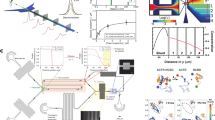Abstract
We developed an in vitro protein expression and interaction analysis platform based on a highly parallel and sensitive microfluidic affinity assay, and used it for 14,792 on-chip experiments, which exhaustively measured the protein-protein interactions of 43 Streptococcus pneumoniae proteins in quadruplicate. The resulting network of 157 interactions was denser than expected based on known networks. Analysis of the network revealed previously undescribed physical interactions among members of some biochemical pathways.




Similar content being viewed by others
References
Arifuzzaman, M. et al. Genome Res. 16, 686–691 (2006).
Parrish, J.R. et al. Genome Biol. 8, R130 (2007).
Shimoda, Y. et al. DNA Res. 15, 13–23 (2008).
Hyde, T.B. et al. J. Am. Med. Assoc. 286, 1857–1862 (2001).
Fields, S. & Song, O. Nature 340, 245–246 (1989).
Aloy, P. & Russell, R.B. Trends Biochem. Sci. 27, 633–638 (2002).
Parrish, J.R., Gulyas, K.D. & Finley, R.L. Jr. Curr. Opin. Biotechnol. 17, 387–393 (2006).
Cusick, M.E., Klitgord, N., Vidal, M. & Hill, D.E. Hum. Mol. Genet. 14 (Special issue 2), R171–R181 (2005).
Lee, C., Chang, J.H., Lee, H.S. & Cho, Y. Genes Dev. 16, 3199–3212 (2002).
Yu, H. et al. Science 322, 104–110 (2008).
Deshaies, R.J. et al. Mol. Cell. Proteomics 1, 3–10 (2002).
Rigaut, G. et al. Nat. Biotechnol. 17, 1030–1032 (1999).
Ho, Y. et al. Nature 415, 180–183 (2002).
Butland, G. et al. Nature 433, 531–537 (2005).
Zhu, H. et al. Science 293, 2101–2105 (2001).
Tarassov, K. et al. Science 320, 1465–1470 (2008).
Maerkl, S.J. & Quake, S.R. Science 315, 233–237 (2007).
Ramachandran, N. et al. Science 305, 86–90 (2004).
Einav, S. et al. Nat. Biotechnol. 26, 1019–1027 (2008).
Edwards, A.M. et al. Trends Genet. 18, 529–536 (2002).
Curnow, A.W., Tumbula, D.L., Pelaschier, J.T., Min, B. & Soll, D. Proc. Natl. Acad. Sci. USA 95, 12838–12843 (1998).
Gancedo, C. & Flores, C.L. Microbiol. Mol. Biol. Rev. 72, 197–210 (2008).
Acknowledgements
We thank members of the Stanford microfluidics foundry for help with device fabrication. This work was supported in part by the US National Institutes of Health Director's Pioneer award (to S.R.Q.) and a Fulbright award (to D.G.).
Author information
Authors and Affiliations
Corresponding author
Ethics declarations
Competing interests
S.R.Q. and S.J.M. are authors on a pending patent based on the results of this research.
Supplementary information
Supplementary Text and Figures
Supplementary Figures 1–4, Supplementary Tables 1–4, Supplementary Methods (PDF 826 kb)
Supplementary Data
Protein interaction list in MIMIx format (XLS 33 kb)
Rights and permissions
About this article
Cite this article
Gerber, D., Maerkl, S. & Quake, S. An in vitro microfluidic approach to generating protein-interaction networks. Nat Methods 6, 71–74 (2009). https://doi.org/10.1038/nmeth.1289
Received:
Accepted:
Published:
Issue Date:
DOI: https://doi.org/10.1038/nmeth.1289
- Springer Nature America, Inc.
This article is cited by
-
Systematic analysis of low-affinity transcription factor binding site clusters in vitro and in vivo establishes their functional relevance
Nature Communications (2022)
-
Affinity microfluidics enables high-throughput protein degradation analysis in cell-free extracts
Communications Biology (2022)
-
Sensitive Readout for Microfluidic High-Throughput Applications using Scanning SQUID Microscopy
Scientific Reports (2020)
-
Microfluidic approaches for the analysis of protein–protein interactions in solution
Biophysical Reviews (2020)
-
Barcoded DNA nanostructures for the multiplexed profiling of subcellular protein distribution
Nature Biomedical Engineering (2019)





